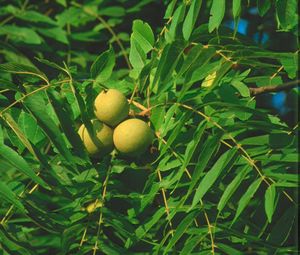Juglans nigra
Black Walnut

Black Walnut, a rapidly growing native tree, is common throughout the Midwest especially in moist bottomlands and open fields. Its beautiful, fine-grained, chocolate-brown heartwood is the ultimate choice for making solid wood furniture, interior trim, gunstocks, and high-quality veneer. The large nut contained beneath the husk is round and can be cracked open to expose the bittersweet, oily, and highly nutritious kernel.
A native of the Eastern, Midwestern, and Great Plains regions of the United States, Black Walnut is a pioneer invader tree in open fields or cut-over woodlots, and grows rapidly in youth. It displays an irregular and open growth habit when young, dividing into several spreading branches that give it an upright rounded shape as it matures. Its bold winter texture makes it an outstanding tree to observe during the dormant season. This tree may easily grow to 70 feet tall by 70 feet wide when it is found in the open. As a member of the Walnut Family, it is related to other Walnuts and to the Hickories.
Additional Information:
The type of relationship between plants, like Black Walnut, in which one produces a substance which affects the growth of another is known as "allelopathy."
|
Height |
Spread |
USDA Hardiness Zone 3-9
Home Owner Growing and Maintenance Tips:
Aside from leaf spot, Black Walnut is virtually disease and pest free. However, it is famous for root production of juglone, a chemical that is toxic to some nearby competitor plants. In a woodland setting, very few plants grow under the canopy of this species. When summer drought occurs, the response of this tree is to begin dropping leaves, in spite of its deep taproot system. The Black Walnut is not the best urban tree because it requires much clean-up from dropped leaflets, dead twigs, stain-laden whole fruits and debris from squirrel feeding.
|
Good Companions
Virginia Creeper
(Parthenocissus quinquefolia),
Red Maple
(Acer rubrum),
Sugar Maple
(Acer saccharum),
Virginia Bluebells
(Mertensia virginica),
Interrupted Fern
(Osmunda claytoniana),
Royal Fern
(Osmunda regalis),
Wild Sweet William
(Phlox divaricata)
|
Characteristics & Attributes
Hydrologic Designation
|
Season of Interest
|
Soil Moisture
|
||||||||||
Sun Exposure
|
USFS MO Ecological Map |
Wildlife Benefit
|
||||||||||
